Chem 210 reactions Study guides, Class notes & Summaries
Looking for the best study guides, study notes and summaries about Chem 210 reactions? On this page you'll find 364 study documents about Chem 210 reactions.
Page 2 out of 364 results
Sort by
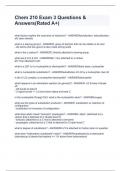
-
Chem 210 Exam 3 Questions & Answers(Rated A+)
- Exam (elaborations) • 8 pages • 2024
-
Available in package deal
-
- $11.49
- + learn more
Chem 210 Exam 3 Questions & Answers(Rated A+) what factors explain the outcomes of reactions? - ANSWERhybridization, delocalization, eN, atom density what is a leaving group? - ANSWER- group of atom(s) that can be stable on its own - eN atoms that are good LG also make strong acids what is the α carbon? - ANSWERC directly attached to leaving group what are β Cs? β Hs? - ANSWERβC: C(s) attached to α carbon βH: H(s) attached to βC what is a LB? is it a nucleophile or elec...
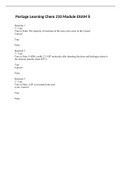
-
Portage Learning Chem 210 Module EXAM 8
- Exam (elaborations) • 12 pages • 2023
-
Available in package deal
-
- $8.49
- + learn more
Portage Learning Chem 210 Module EXAM 8 Question 1 3 / 3 pts True or False: The majority of reactions of the urea cycle occur in the cytosol. Correct! True False Question 2 3 / 3 pts True or False: FADH2 yields 2.5 ATP molecules after donating electrons and hydrogen atoms to the electron transfer chain (ETC). True Correct! False Question 3 3 / 3 pts True or False: ATP is invested in the urea cycle. Correct! True False

-
Chem 210 Portage Learning Final Exam| Questions and Verified Answers| 2023/ 2024 Update
- Exam (elaborations) • 15 pages • 2023
-
Available in package deal
-
- $10.49
- + learn more
Chem 210 Portage Learning Final Exam| Questions and Verified Answers| 2023/ 2024 Update Question 3 / 3 pts Any molecule or ion that is necessary for an enzyme’s function is called a Cofactor Coreactant Coproduct Bienzyme Both B and C COFACTOR Question 3 / 3 pts A(n) is a compound that binds to an enzyme in such a way that the enzyme slows down or stop the enzyme reactions. Ligand Substrate Inhibitor Coenzyme Deactivator INHIBITOR Q...
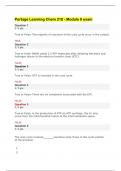
-
Portage Learning Chem 210 - Module 8 exam
- Exam (elaborations) • 13 pages • 2023
-
Available in package deal
-
- $9.79
- + learn more
Portage Learning Chem 210 - Module 8 exam True or False: The majority of reactions of the urea cycle occur in the cytosol. TRUE True or False: NADH yields 1.5 ATP molecules after donating electrons and hydrogen atoms to the electron transfer chain (ETC). FALSE True or False: GTP is invested in the urea cycle. FALSE True or False: There are six complexes associated with the ETC. FALSE True or False: In the production of ATP via ATP synthase, the H+ ions move from t...
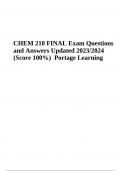
-
CHEM 210 Biochemistry: FINAL Exam Questions and Answers Updated 2023/2024.
- Exam (elaborations) • 15 pages • 2023
-
- $19.49
- + learn more
CHEM 210 Biochemistry: FINAL Exam Questions and Answers Updated 2023/2024. Which of the following is the enthalpy change of a reaction? A) ΔG B) ΔS C) ΔH D) ΔF E) None of the above C Question 12 3 / 3 pts The following is what type of protein secondary structure? Alpha helix Beta turn Parallel beta sheet Anti-parallel beta sheet Globular sheet ANTI-PARALLEL BETA SHEET Question 13 3 / 3 pts A globular protein is an example of a protein __________. motif Conformation...
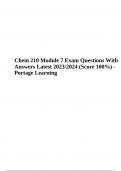
-
Chem 210 Module 7 Exam Review Questions With Answers Latest 2023/2024 (Verified)
- Exam (elaborations) • 14 pages • 2023
-
- $15.49
- + learn more
Chem 210 Module 7 Exam Review Questions With Answers Latest 2023/2024 (Verified) In glycolysis, when glucose enters a cell, it is immediately phosphorylated to form glucose-6-phosphate. The phosphate donor in this reaction is ATP, and the enzyme is ________. Hexokinase Aldolase CoA Phosphohexose isomerase None of the above HEXOKINASE Question 10 3 / 3 pts In the last reaction of glycolysis, ATP is formed by the direct transfer of a phosphate group from a metabolite to ADP. This...
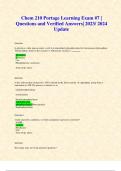
-
Chem 210 Portage Learning Exam #7 | Questions and Verified Answers| 2023/ 2024 Update
- Exam (elaborations) • 10 pages • 2023
-
Available in package deal
-
- $9.49
- + learn more
Chem 210 Portage Learning Exam #7 | Questions and Verified Answers| 2023/ 2024 Update Question In glycolysis, when glucose enters a cell, it is immediately phosphorylated to form glucose-6-phosphate. The phosphate donor in this reaction is ATP, and the enzyme is . Hexokinase Aldolase CoA Phosphohexose isomerase None of the above Question In the sixth reaction of glycolysis, ATP is formed by the direct transfer of a phosphate group from a metabolite ...
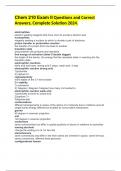
-
Chem 210 Exam II Questions and Correct Answers, Complete Solution 2024.
- Exam (elaborations) • 4 pages • 2024
-
Available in package deal
-
- $9.99
- + learn more
Chem 210 Exam II Questions and Correct Answers, Complete Solution 2024. electrophiles electron seeking reagents that have room to accept a electron pair nucleophiles reagents seeking a nucleus to which to donate a pair of electrons proton transfer or protonation reaction the transfer of a proton from one base to another transition state lying between the products and reactants free energy of activation (delta G double dagger) the height of the barrier, the energy that the reactants a...
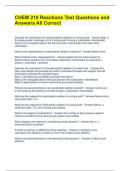
-
CHEM 210 Reactions Test Questions and Answers All Correct
- Exam (elaborations) • 3 pages • 2024
- Available in package deal
-
- $8.49
- + learn more
CHEM 210 Reactions Test Questions and Answers All Correct Describe the mechanism for the electrophilic addition of a strong acid. - Answer-Step 1) An alkene grabs a hydrogen off of a strong acid, forming a carbocation intermediate. Step 2) The conjugate base of the acid (an anion now) bonds to the open shell carbocation What is the regioselectivity of electrophilic addition reactions? - Answer-Markovnikov What is Markovnikov regioselectivity? - Answer-States that the major product is d...
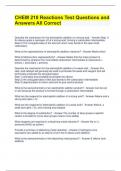
-
CHEM 210 Reactions Test Questions and Answers All Correct
- Exam (elaborations) • 3 pages • 2024
-
Available in package deal
-
- $7.59
- + learn more
CHEM 210 Reactions Test Questions and Answers All Correct Describe the mechanism for the electrophilic addition of a strong acid. - Answer-Step 1) An alkene grabs a hydrogen off of a strong acid, forming a carbocation intermediate. Step 2) The conjugate base of the acid (an anion now) bonds to the open shell carbocation What is the regioselectivity of electrophilic addition reactions? - Answer-Markovnikov What is Markovnikov regioselectivity? - Answer-States that the major product is d...

$6.50 for your textbook summary multiplied by 100 fellow students... Do the math: that's a lot of money! Don't be a thief of your own wallet and start uploading yours now. Discover all about earning on Stuvia


